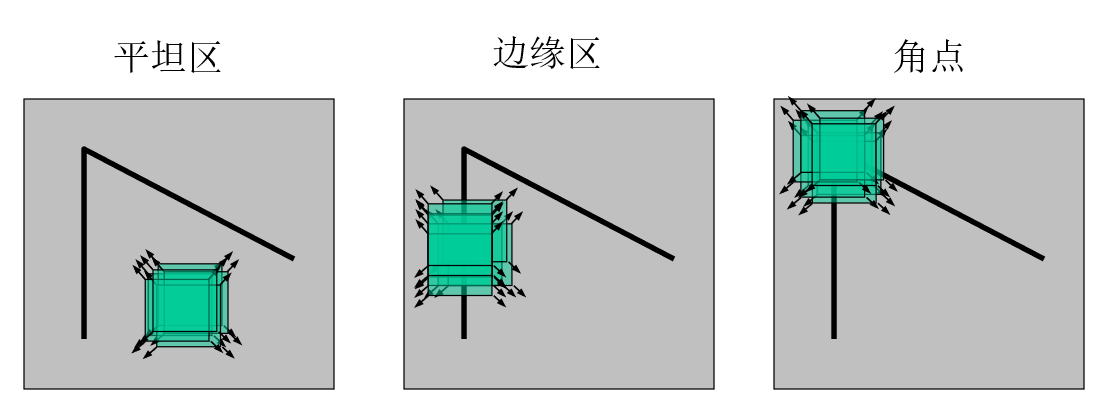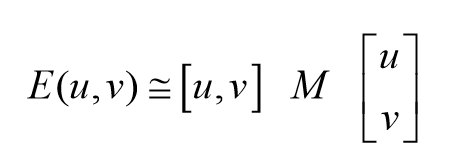1.Harris角点检测
1.1原理
角点
通常意义上来说,角点就是极值点,即在某方面属性特别突出的点,是在某些属性上强度最大或者最小的孤立点、线段的终点。而对于图像而言,如图所示红点部分,即为图像的角点,其是物体轮廓线的连接点。
角点检测
对于图像的角点判断,可以假想出一个正方形的小窗口,如果小窗口在图像以任意方向进行移动,导致图像灰度的明显变化,那么我们就可以认为小窗口内部包含了“角点”,或者当窗口足够小时,可以认为该窗口就是角点。
 当窗口位于平坦区时,任意方向移动都没有灰度变化。
当窗口位于平坦区时,任意方向移动都没有灰度变化。
当窗口位于边缘区时,沿边缘方向移动无灰度变化。
当窗口位于角点时,沿任意方向移动都会有明显的灰度变化。
Harris算法
Harris算法使用微分运算和自相关矩阵来进行角点检测,具有运算简单、提取的角点特征均匀合理、性能稳定等特点。
假设图像像素点(x,y)的灰度为 I(x,y),以像素点为中心的窗口沿 x 和 y 方向分别移动 u 和 v 的灰度强度变化的表达式为:

其中 E(u,v)是灰度变化,w(x,y) 是窗口函数,一般是高斯函数,所以可以把w(x,y)看做是高斯滤波器。I(x,y)是图像灰度, I(x+u,y+v)是平移后的图像灰度。
收到泰勒公式的启发,在这里我们可以将 I(x+u,y+v)函数在(x,y)处泰勒展开,为了提高抗干扰的能力并且简化运算,我们取到了一阶导数部分,后面的无穷小小量O(u2+v2)可以忽略,整理得到表达式如下:
展开后变型可以近似得到E(x,y)的表达式

记M得特征值为λ1,λ2

如图进行分类

det M是矩阵M的行列式,Trace(M)为矩阵M的迹。k为修正值,是一个常数,经验取值为0.04-0.06。算出响应值之后,根据R与阈值T的比较来判断是否为角点。
当|R|很小时,R<T , 认为该点处于图像的平坦区域。
当R<0时,R<T , 认为该点处于图像的边缘区。
当R>0时,R>T, 认为该点位置就是图像角点。
1.2代码
from PIL import Image
from pylab import *
from scipy.ndimage import filters
def compute_harris_response(im, sigma=3):
"""在一幅灰度图像中,对每个像素计算Harris角点检测器响应函数"""
# 计算导数
imx = zeros(im.shape)
filters.gaussian_filter(im, (sigma, sigma), (0,1), imx)
imy = zeros(im.shape)
filters.gaussian_filter(im, (sigma, sigma), (1,0), imy)
# 计算Harris矩阵的分量
Wxx = filters.gaussian_filter(imx*imx, sigma)
Wxy = filters.gaussian_filter(imx*imy, sigma)
Wyy = filters.gaussian_filter(imy*imy, sigma)
# 计算特征值和迹
Wdet = Wxx * Wyy - Wxy**2
Wtr = Wxx + Wyy
return Wdet / Wtr
def get_harris_points(harrisim, min_dist=10, threshold=0.1):
"""从一幅Harris响应图像中返回角点。min_dist为分割角点和图像边界的最小像素数目"""
# 寻找高于阈值的候选角点
corner_threshold = harrisim.max() * threshold
harrisim_t = (harrisim > corner_threshold) * 1
# 得到候选点的坐标
coords = array(harrisim_t.nonzero()).T
# 以及它们的Harris响应值
candidate_values = [harrisim[c[0], c[1]] for c in coords]
# 对候选点按照Harris响应值进行排序
index = argsort(candidate_values)
# 将可行点的位置保存到数组中
allowed_locations = zeros(harrisim.shape)
allowed_locations[min_dist:-min_dist,min_dist:-min_dist] = 1
# 按照min_distance原则,选择最佳Harris点
filtered_coords = []
for i in index:
if allowed_locations[coords[i,0], coords[i,1]] == 1:
filtered_coords.append(coords[i])
allowed_locations[(coords[i,0]-min_dist):(coords[i,0]+min_dist),
(coords[i,1]-min_dist):(coords[i,1]+min_dist)] = 0
return filtered_coords
def get_harris_points(harrisim, min_dist=10, threshold=0.1):
# 寻找高于阈值的候选角点
corner_threshold = harrisim.max() * threshold
# print(corner_threshold)
harrisim_t = (harrisim > corner_threshold) * 1
# plt.imshow(harrisim_t, plt.cm.gray)
# 得到候选点的坐标(取出是角点的坐标)
coords = array(harrisim_t.nonzero()).T
# print(coords.shape)
# 以及它们的Harris响应值
candidate_values = [harrisim[c[0], c[1]] for c in coords]
# 对候选点按照Harris响应值进行排序
index = argsort(candidate_values)
# 将可行点的位置保存到数组中
allowed_location = zeros(harrisim.shape)
# 相当于把外面一圈有响应值的点先舍去(匹配主体在中心)
allowed_location[min_dist:-min_dist, min_dist:-min_dist] = 1
# 按照min_distance原则,选择最佳的Harris角点
filtered_coords = []
for i in index:
if allowed_location[coords[i, 0], coords[i, 1]] == 1:
filtered_coords.append(coords[i])
allowed_location[(coords[i, 0] - min_dist):(coords[i, 0] + min_dist),
(coords[i, 1] - min_dist):(coords[i, 1] + min_dist)] = 0
return filtered_coords
# 绘制图像中检测到的角点
def plot_harris_points(image, filtered_coords):
"""绘制图像中检测到的角点"""
figure()
gray()
imshow(image)
plot([p[1] for p in filtered_coords], [p[0] for p in filtered_coords], '*')
axis('off')
show()
'''
if "__main__" == __name__:
# 打开灰度图convert('L')
im = array(Image.open('./screen/2/6.png').convert('L'))
harrisim = compute_harris_response(im)
filtered_coords = get_harris_points(harrisim, 6)
plot_harris_points(im, filtered_coords)
'''
def get_descriptors(image, filtered_coords, wid=5):
"""返回点周围2*wid+1个像素的值"""
desc = []
for coords in filtered_coords:
patch = image[coords[0] - wid:coords[0] + wid + 1,
coords[1] - wid:coords[1] + wid + 1].flatten()
desc.append(patch)
return desc
def match(desc1, desc2, threshold=0.5):
"""归一化互相关"""
n = len(desc1[0])
d = -ones((len(desc1), len(desc2)))
#点对的距离
for i in range(len(desc1)):
for j in range(len(desc2)):
d1 = (desc1[i] - mean(desc1[i])) / std(desc1[i])
d2 = (desc2[j] - mean(desc2[j])) / std(desc2[j])
ncc_value = sum(d1 * d2) / (n-1)
if ncc_value > threshold:
d[i, j] = ncc_value
ndx = argsort(-d)
matchscores = ndx[:, 0]
return matchscores
def match_twosided(desc1, desc2, threshold=0.5):
"""两边对称版本的match"""
matches_12 = match(desc1, desc2, threshold)
matches_21 = match(desc2, desc1, threshold)
ndx_12 = where(matches_12 >= 0)[0]
# 去除非对称的匹配
for n in ndx_12:
if matches_21[matches_12[n]] != n:
matches_12[n] = -1
return matches_12
def appendimages(img1, img2):
"""返回两幅图像并拼接成一幅新图像"""
rows1 = img1.shape[0]
rows2 = img2.shape[0]
if rows1 < rows2:
img1 = concatenate(
(img1, zeros((rows2 - rows1, img1.shape[1]))), axis=0)
elif rows1 > rows2:
img2 = concatenate(
(img2, zeros((rows1 - rows2, img2.shape[1]))), axis=0)
return concatenate((img1, img2), axis=1)
def plot_matches(img1, img2, locs1, locs2, matchscores, show_below=True):
"""显示一幅带有连接匹配之间连线的图片"""
img3 = appendimages(img1, img2)
if show_below:
img3 = vstack((img3, img3))
imshow(img3)
cols1 = img1.shape[1]
for i, m in enumerate(matchscores):
if m > 0:
plot([locs1[i][1], locs2[m][1] + cols1],
[locs1[i][0], locs2[m][0]], 'c')
axis('off')
if "__main__" == __name__:
# 打开灰度图convert('L')
img1 = array(Image.open('./screen/2/5.png').convert('L'))
img2 = array(Image.open('./screen/2/6.png').convert('L'))
wid = 5
harrisim = compute_harris_response(img1, 5)
filtered_coords1 = get_harris_points(harrisim, wid + 1)
d1 = get_descriptors(img1, filtered_coords1, wid)
harrisim = compute_harris_response(img2, 5)
filtered_coords2 = get_harris_points(harrisim, wid + 1)
d2 = get_descriptors(img2, filtered_coords2, wid)
print("starting matching")
matches = match_twosided(d1, d2)
figure()
gray()
plot_matches(img1, img2, filtered_coords1, filtered_coords2, matches)
show()3 实验结果
原图


结果:
2 SIFT特征
2.3实验结果


